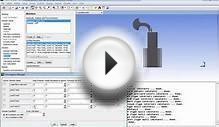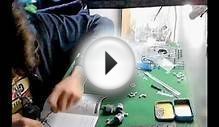
Adam Kemp: Hi, I am Adam Kemp and today we are learning about Internal Combustion engines. In this clip, I am going to give an overview of the entire mechanical system that makes up an Internal Combustion engine. For today's engine, I am going to be using a 6 HP Tecumseh Go kart engine. The reason I have chosen this engine is because the mechanical components that make it up are similar to what are found in most automobiles. To begin illustrating the mechanical components in the Internal combustion engine, we are going to start with the piston. The piston is a mechanical device that slides up and down inside the combustion chamber bringing fuel and air during it's first cycle into the combustion chamber, compressing it during it's compression cycle and it's what's used to convert the chemical energy into mechanical energy. The piston consists of four main components, the piston head, the piston rings, two of which are compression rings and one special ring is used to hold oil against the walls of the cylinder, called an oil ring, the pivot bushing and then the piston arm. And attached to this arm is an oil thrower which is used to disperse oil inside of the crankcase maintaining lubrication throughout the system. The second component I am going illustrate is the crankshaft. The crankshaft is the mechanical linkage between the drive shaft and the piston assembly. The piston is attached to the center of this crankshaft and oscillates up and down as the crankshaft rotates. Another feature of this crankshaft is a gear which links the motion of the crankshaft to the camshaft which I will illustrate next.
The Camshaft is an important component in this engine that has two lobed features on it. These two lobes help lift the lifters, which in turn open and close the corresponding inlet valve and exhaust valve which brings gas and air into the combustion chamber and pushes exhaust gases out of the combustion chamber. Final component of the mechanical system I am going to illustrate is the valve system. This valve system consists of two valves. We have our inlet valve which brings gas and air into the combustion chamber and the exhaust valve which expels the exhaust vapors out of the engine to prepare it for it's next cycle. We have rockers much like in a car, we have lifters and have corresponding hardware for the lifter system. We have valve springs and then the valve spring caps. All these components work together and can be better illustrated with my engine model. To illustrate all of the components in the mechanical system working together, I am going to start with the engine's first cycle. The piston is situated in it's topmost point, the engine begins to rotate, the crankshaft pulls the piston down, the inlet valve is going to suck gas and air into the combustion chamber. Once the piston reaches the bottom of it's throw, the inlet valve is going to close and the piston will begin to compress those gas and air mixture. Once the piston reaches it's topmost point, the spark plug is going to fire, forcing the piston down and then once it begins to come back up again, the exhaust valve is going to open and release those exhaust gases into the atmosphere.
This completes my overview of the mechanical components that make up the mechanical system in the Internal Combustion engine. Coming up next is a clip about how the electrical system works and in a one cylinder Internal Combustion engine.
To watch the other segments in this video series or for How to videos on almost any other topic, visit monkeysee.
RELATED VIDEO












